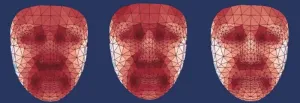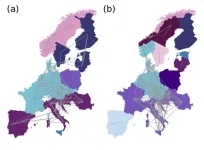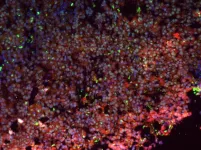(Press-News.org) A research effort led by scientists at the U.S. Department of Energy’s (DOE’s) National Renewable Energy Laboratory (NREL) has made advances that could enable a broader range of currently unimagined optoelectronic devices.
The researchers, whose previous innovation included incorporating a perovskite layer that allowed the creation of a new type of polarized light-emitting diode (LED) that emits spin-controlled photons at room temperature without the use of magnetic fields or ferromagnetic contacts, now have gone a step further by integrating a III-V semiconductor optoelectronic structure with a chiral halide perovskite semiconductor. That is, they transformed an existing commercialized LED into one that also controls the spin of electrons. The results provide a pathway toward transforming modern optoelectronics, a field that relies on the control of light and encompasses LEDs, solar cells, and telecommunications lasers, among other devices.
“It's up to one's imagination where this might go or where this might end up,” said Matthew Beard, a senior research fellow at NREL and coauthor of the newly published Nature article, “Room temperature spin injection across a chiral-perovskite/III-V interface.”
Beard also serves as director of the Center for Hybrid Organic Inorganic Semiconductors for Energy (CHOISE), an Energy Frontier Research Center funded by the Office of Science Basic Energy Sciences within DOE. The reported research was funded by CHOISE and relied on a broad range of scientific expertise drawn from NREL, the Colorado School of Mines, University of Utah, University of Colorado Boulder, and the Universite de Lorraine in France.
The goal of CHOISE is to understand control over the interconversion of charge, spin, and light using carefully designed chemical systems. In particular, the work focuses on control over the electron spin that can be either “up” or “down.” Most current-day optoelectronic devices rely on the interconversion between charge and light. However, spin is another property of electrons, and control over the spin could enable a wide plethora of new effects and functionality. The researchers published a paper in 2021 in which they reported how by using two different perovskite layers they were able to control the spin by creating a filter that blocks electrons “spinning” in the wrong direction.
They hypothesized at the time that advancements could be made in optoelectronics if they could successfully incorporate the two semiconductors, and then went on to do just that. The breakthroughs made, which include eliminating the need for subzero Celsius temperatures, can be used to increase data processing speeds and decrease the amount of power needed.
“Most current-day technologies are all based on controlling charge,” Beard said. “Most people just forget about the electron spin, but spin is very important, and it's also another parameter that one can control and utilize.”
Manipulating the spin of electrons in a semiconductor has previously required the use of ferromagnetic contacts under an applied magnetic field. Using chiral perovskites, the researchers were able to transform an LED to one that emits polarized light at room temperature and without a magnetic field. Chirality refers to the material's structure that cannot be superimposed on its mirror image, such as a hand. For example, a “left-handed” oriented chiral system may allow transport of electrons with “up” spins but block electrons with “down” spins, and vice versa. The spin of the electron is then converted to the “spin,” or polarization, of the emitted light. The degree of polarization, which measures the intensity of light that is polarized in one direction, reached about 2.6% in the previous research. The addition of the III-V semiconductor—which is made of materials in the third and fifth columns of the periodic table—boosted the polarization to about 15%. The degree of polarization serves as a direct measure of spin accumulation in the LED.
“This work is particularly exciting to me, as it combines spin functionality with a traditional LED platform,” said the first author of the work, Matthew Hautzinger. “You can buy an LED analogous to what we used for 14 cents, but with the chiral perovskite incorporated, we’ve transformed an already robust (and well understood) technology into a futuristic spin-control device.”
Other NREL researchers listed as coauthors are Steven Hayden, Jiselle Ye, Qi Jiang, Mickey Wilson, Alan Phillips, Yifan Dong, Emily Raulerson, Ian Leahy, Chun-Sheng Jiang, Jeffrey Blackburn, Joseph Luther, Katherine Jungjohann, Joseph Berry, and Kirstin Alberi.
NREL is the U.S. Department of Energy's primary national laboratory for renewable energy and energy efficiency research and development. NREL is operated for DOE by the Alliance for Sustainable Energy LLC.
END
Optoelectronics gain spin control from chiral perovskites and III-V semiconductors
2024-07-02
ELSE PRESS RELEASES FROM THIS DATE:
Doctors could soon use facial temperature for early diagnosis of metabolic diseases
2024-07-02
A colder nose and warmer cheeks may be a telltale sign of rising blood pressure.
Researchers discovered that temperatures in different face regions are associated with various chronic illnesses, such as diabetes and high blood pressure. These temperature differences are not easily perceptible by one’s own touch but can instead be identified using specific AI-derived spatial temperature patterns that require a thermal camera and a data-trained model. The results appear July 2 in the journal Cell Metabolism. With ...
Engineered plasma cells show long-lasting antileukemic activity in mice
2024-07-02
Researchers show for the first time that engineered human plasma B cells can be used to treat a disease—specifically leukemia—in a humanized animal model. The results mark a key step in the realization of ePCs as therapies to treat cancer, auto-immune disorders, and protein deficiency disorders. The results appear July 2 in the journal Molecular Therapy.
“We hope that this proof-of-concept study is the first of many applications of engineered plasma B cells, and eventually will lead to a single-shot therapeutic,” says senior study author Richard James (@ScienceRicker) of the Seattle Children’s ...
Proteins and fats can drive insulin production for some, paving way for tailored nutrition
2024-07-02
When it comes to managing blood sugar levels, most people think about counting carbs. But new research from the University of British Columbia shows that, for some, it may be just as important to consider the proteins and fats in their diet.
The study, published today in Cell Metabolism, is the first large-scale comparison of how different people produce insulin in response to each of the three macronutrients: carbohydrates (glucose), proteins (amino acids) and fats (fatty acids).
The findings reveal that production of the blood sugar-regulating hormone insulin is much more dynamic and individualized than previously ...
Melting of Alaskan glaciers accelerating faster than previously thought
2024-07-02
Melting of glaciers in a major Alaskan icefield has accelerated and could reach an irreversible tipping point earlier than previously thought, new research suggests.
The research, led by scientists at Newcastle University, UK, found that glacier loss on Juneau Icefield, which straddles the boundary between Alaska and British Columbia, Canada, has increased dramatically since 2010.
The team, which also included universities in the UK, USA and Europe, looked at records going back to 1770 and identified three distinct periods in how icefield volume changed. They saw that glacier volume loss remained fairly ...
Genetic study points to oxytocin as possible treatment for obesity and postnatal depression
2024-07-02
Scientists have identified a gene which, when missing or impaired, can cause obesity, behavioural problems and, in mothers, postnatal depression. The discovery, reported today in Cell, may have wider implications for the treatment of postnatal depression, with a study in mice suggesting that oxytocin may alleviate symptoms.
Obesity and postnatal depression are significant global health problems. Postnatal depression affects more than one in 10 women within a year of giving birth and is linked to an increased risk of ...
What was behind the 2021-2022 energy crisis within Europe?
2024-07-02
WASHINGTON, July 2, 2024 – An energy crisis hit Europe in 2021-2022, following Russia’s invasion of Ukraine, which sent electricity prices skyrocketing — even within countries that don’t rely on Russian gas. It begs the question: Was there more to it?
A team of researchers from the Institute for Energy and Climate Research at Forschungszentrum Jülich, the University of Cologne, and the Norwegian University of Life Sciences had already been working with electricity price data for years, exploring statistics and developing forecasting methods. Adopting a European perspective, ...
Alterations in human gene TRPC5 cause obesity and postpartum depression
2024-07-02
Researchers at Baylor College of Medicine, the University of Cambridge and collaborating institutions have discovered that alterations in the human gene TRPC5 cause obesity and postpartum depression.
Taken together, their studies in cells, animal models and humans showed that TRPC5 acts on distinct neuronal populations in the hypothalamus, a brain region that regulates multiple innate behaviors including feeding, anxiety, socialization and maternal care. The findings, published in the journal Cell, ...
In-hospital delirium and disability and cognitive impairment after COVID-19 hospitalization
2024-07-02
About The Study: In this cohort study of 311 hospitalized older adults with COVID-19, in-hospital delirium was associated with increased functional disability and cognitive impairment over the 6 months following discharge. Older survivors of a COVID-19 hospitalization who experience in-hospital delirium should be assessed for disability and cognitive impairment during postdischarge follow-up.
Corresponding author: To contact the corresponding author, Lauren E. Ferrante, M.D., M.H.S., email lauren.ferrante@yale.edu.
To access the embargoed study: Visit our For The Media website at this link https://media.jamanetwork.com/
(doi: 10.1001/jamanetworkopen.2024.19640)
Editor’s ...
E-cigarette use and lung cancer screening uptake
2024-07-02
About The Study: In this cross-sectional study, e-cigarette use was independently associated with lower use of lung cancer screening, particularly among individuals who had quit smoking combustible cigarettes. Emerging research suggests that e-cigarettes contain definite and probable carcinogens and cause similar cancer-associated gene deregulations as combustible tobacco.
Corresponding author: To contact the corresponding author, Qian Wang, M.D., M.P.H., email qian.wang@uhhospitals.org.
To access the embargoed study: Visit our For The Media website at this link https://media.jamanetwork.com/
(doi: ...
A study led by UPF describes how insulinomas, a rare type of pancreatic beta cell tumor, form
2024-07-02
An experimental study led by Pompeu Fabra University describes the mechanism whereby insulinomas, a rare type of neuroendocrine tumour that affects pancreatic beta cells. According to the study, insulinomas are the result of the accumulation of rare mutations that lead to a homogeneous change in the epigenetic profile of pancreatic beta cells. This profile change causes beta cells to express unusually high levels of oncogenes, growth and transcription factors, and genes related to insulin production.
Insulinomas are rare pancreatic neuroendocrine tumours that involve the excessive growth of beta cells, which are responsible for secreting insulin. Often, they are diagnosed ...


